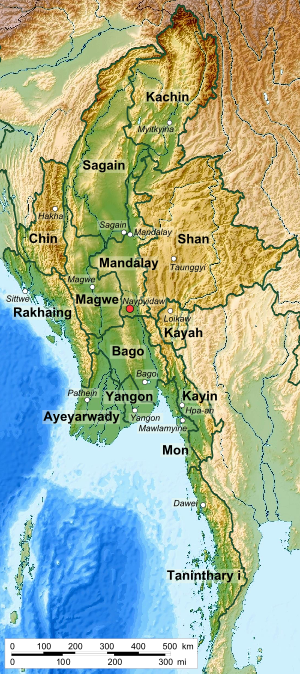Introduction
Myanmar occupies a central position in India’s “Look East Policy” or “Act East Policy” and has received highest level political patronage under the Modi doctrine. Continuity in India’s policy has received attention in the neighborhood especially when the situation is in a flux and following China’s belligerent moves in the region.

Strategic Thrust of Look East Policy
The strategic thrust takes into account the need for political and economic stability in Myanmar as also to ensure India’s participation in key sectors, improving its image and visibility and importantly to create greater synergy and influence in bilateral relations. Myanmar is India’s bridge to Southeast Asia and beyond. India’s northeast region is a vital part of the Modi doctrine and both embrace the Look East Policy.
Pillars of Change
Myanmar has emerged from decades of military or single party rule and is now well on the road to multi-party democracy. The change is articulated by the results of parliamentary elections two years ago that gave the National League for Democracy (NLD) the mandate to govern the country. The transition is irreversible and it must be strengthened by all stakeholders both within the country and outside. It is important that Myanmar must move beyond the status quo to creating conditions for political stability, good governance, and economic development and address deficit trust in critical areas. The progress is slow in achievement of the development manifesto and calls for patience and understanding of the evolving scenario.
Myanmar’s major target today is to create conditions conducive for all round economic development and improve quality of living standards of its people. Myanmar requires reliable and long term partners in vision and substance. India is well placed to share its experience to assist Myanmar in all spheres of activity especially in restoring its critical administrative infrastructure so vital for planning and implementation of development plans. Further, there is considerable scope for creating greater synergy between the corporate sectors of both countries. Long years of military rule resulted in the withering away of its civil services and also created a political vacuum. It needs to address this area sooner than later for meeting its development objectives.
Out of Box Thinking
Political relations between both countries are at unprecedented levels. This has set the tone for other areas of bilateral relations. The government is looking at several options to consolidate the relationship. One initiative is related to the creation of a joint parliamentary friendship group between the legislative bodies of both countries as way forward. The Parliamentary Friendship Group (PFG) which is part of the Indian Parliamentary Group (IPG) will be the ideal platform for the proposed bilateral forum. The IPG has been in existence since 1949 and has rich experience in the field of bilateral relations with its counterparts overseas including regional and international bodies and Associations.
Establishment of a Parliamentary Friendship Group (PFG)
The establishment of a formal and permanent joint parliamentary forum between India and Myanmar is a strategic necessity for a variety of reasons. It should become an integral part of the Look East Policy (LEP) with emphasis on people to people contact and importantly promote personal contacts between Members of Parliament of both countries. The proposed “India-Myanmar Joint Parliamentary Forum (IMJPF)” should preferably include representatives of the 27 Members of Parliament from the Northeast region or the Northeast MP’s Forum.
This will be in keeping with the Modi doctrine where India’s Northeast region is the key to development of relations with Myanmar and beyond. Such an arrangement can also be made individually with Bangladesh, Bhutan, Laos, Cambodia and Vietnam either under the BIMSTEC or ASEAN+SAARC-Pakistan umbrella. Myanmar is already a part of the Lao-Singapore and Myanmar Parliamentarians Friendship Group and has several bilateral parliamentary friendship arrangements.
From India’s perspective a multi-structured bilateral parliamentary friendship arrangement with Myanmar will be a force-multiplier. The Myanmar Parliament (Pyidaungsu Hluttaw) comprises of two Huttaw’s or Houses, The Pyithu Hluttaw (Lower House) has 330 members elected on the basis of township as well as population basis and not more than 110 members representing the armed forces (Tatmawdaw) are nominated by the Commander-in-Chief of the Defence Services. The Amyotha Hluttaw (Upper House) has 168 members elected in equal numbers from Regions and States and not more than 56 of them, being the Defense Forces personnel, are nominated by the Commander-in-Chief of the Defence Services. This is a critical mass of Myanmar legislators who are expected to lead Myanmar on its journey forward, they comprise the majority members of the National League for Democracy (NLD), the Union Solidarity and Development Party and other smaller but important political parties. The Myanmar Parliament is therefore at the apex of the bilateral parliamentary interaction.

In its desire to enhance image and visibility in Myanmar, India has also to look at the States and Regions such as Yangon, Bago and Karen that have announced major development projects for their respective jurisdictions. Some of these have plans to mount trade delegations overseas to attract investment and technology. There are others too like Kachin, Shan, Rakhine and Mon who need to be brought on to India’s radar especially in agriculture, primary health and education, rural electrification, food processing and social forestry sector. Time is at hand for the Indian industry Associations and corporate entities to consider inviting Myanmar counterparts for road shows to show case Indian development scenario as also to visit Myanmar for interaction. It is desirable to promote India as First Destination for meeting Myanmar’s requirements since India has much more to offer than Myanmar’s traditional trade and business partners.
India tops the list of countries for participation in these sectors. This is an unprecedented situation for India as also the opportune time to look at involvement in the micro-levels.
Development Projects
India has recently created a Rs. 500 crore Project Development Fund for catalyzing Indian economic presence in Cambodia, Laos, Vietnam and Myanmar (CMLV) states under the umbrella of Ministry of Commerce and operated by the EXIM Bank. An exclusive fund for Myanmar is advocated to financing projects locally with the involvement of local legislative bodies which is critical for economic development.

Links with Regional Legislative Bodies
Some of the States and Regions of Myanmar share common international border with Arunachal Pradesh, Nagaland, Manipur and Mizoram and have age old links. It would be in India’s interest to develop plans to reach out to members of the Amoytha Hluttaw as also local legislative bodies especially whose good offices are important towards participation in local developmental programs. Funds available under the Border Areas Development Program (BADP) of the Home Ministry may be utilized for disaster management, skills development projects and training.
Regional Parliamentary Linkages
By the same token, the role of the Indian legislatures of Arunachal Pradesh, Nagaland, Manipur and Mizoram respectively to play a limited international role is equally important. Cross-border legislative contacts in a formal sense will be mutually beneficial to both countries. Matters of regional development, trade, commerce and industry, environment, health care, environment, prevention of human trafficking and narcotics, cultural, people-to-people contacts and tourism are recommended for India-Myanmar border region. It is worthwhile for India to engage with other States and Regions in Myanmar that require greater Indian attention and specific plans need to be developed to integrate them into India’s strategic policy. Contacts with these have been limited for a variety of reasons. Informal relations with these entities have to become structured and operated on a designated road map. Guwahati in India and either Monywa or Mandalay in Myanmar are ideal locations for regional parliamentary interaction.
Conclusion
The benefits accruing from multi-structured parliamentary association between India and Myanmar are going to add value to bilateral relations besides becoming a precursor to changes in other areas. Exchange of information and knowledge on national, regional and international developments will led to deepening of understanding of each other’s policies. The two governments have agreed to setting up the Eminent Persons Group (EPG), which is a step in the right direction. The bilateral parliamentary friendship group in tandem with EPG will become engines of positive growth and for Myanmar it will be a force multiplier of immense proportions. It may even create the groundswell for Myanmar’s entry into the Commonwealth.
(PM Heblikar is Managing Trustee, Institute of Contemporary Studies Bangalore (ICSB) and former Special Secretary, Government of India)
Image Source: http://www.globalnewlightofmyanmar.com/union-foreign-affairs-minister-meets-with-indian-minister-of-state-for-external-affairs-in-laos/










Post new comment